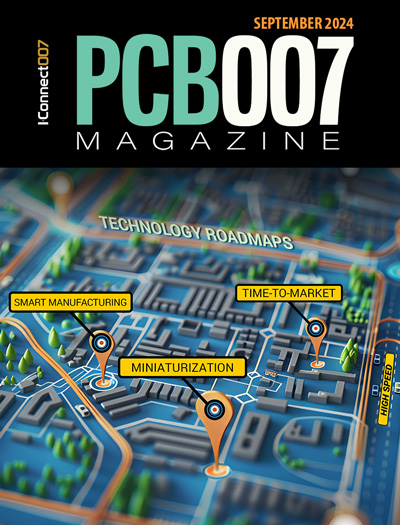-

- News
- Books
Featured Books
- pcb007 Magazine
Latest Issues
Current Issue
Engineering Economics
The real cost to manufacture a PCB encompasses everything that goes into making the product: the materials and other value-added supplies, machine and personnel costs, and most importantly, your quality. A hard look at real costs seems wholly appropriate.

Alternate Metallization Processes
Traditional electroless copper and electroless copper immersion gold have been primary PCB plating methods for decades. But alternative plating metals and processes have been introduced over the past few years as miniaturization and advanced packaging continue to develop.

Technology Roadmaps
In this issue of PCB007 Magazine, we discuss technology roadmaps and what they mean for our businesses, providing context to the all-important question: What is my company’s technology roadmap?
- Articles
- Columns
Search Console
- Links
- Media kit
||| MENU - pcb007 Magazine
AI-Driven Growth in Datacenter Energy Consumption, Predicts Surge in Datacenter Facility Spending Amid Rising Electricity Costs
September 24, 2024 | IDCEstimated reading time: 2 minutes
Datacenters are the heart of the digital economy and the demand for datacenters is expected to rise substantially, positioning them as a primary focus for growth and investment. But the cost of operating datacenters is also rising substantially due to rising electricity prices and increased datacenter consumption. A new International Data Corporation (IDC) report looks at datacenter electricity spending and the implications for technology providers and datacenter operators.
Electricity is by far the largest ongoing expense for datacenter operators, accounting for 46% of total spending for enterprise datacenters and 60% for service provider datacenters. And electricity consumption is growing rapidly as datacenters take on more workloads and more energy-intensive workloads, such as artificial intelligence.
IDC expects the surging demand for AI workloads will lead to a significant increase in datacenter capacity, energy consumption, and carbon emissions, with AI datacenter capacity projected to have a compound annual growth rate (CAGR) of 40.5% through 2027. Accordingly, AI datacenter energy consumption is forecast to grow at a CAGR of 44.7%, reaching 146.2 Terawatt hours (TWh) by 2027 with AI workloads consuming a growing portion of total datacenter electricity use.
Overall, IDC expects global datacenter electricity consumption to more than double between 2023 and 2028 with a five-year CAGR of 19.5% and reaching 857 Terawatt hours (TWh) in 2028.
At the same time, electricity prices are rising due to supply and demand dynamics, environmental regulations, geopolitical events, and sensitivity to extreme weather events fueled in part by climate change. IDC believes the trends that have caused electricity prices to increase over the last five years are likely to continue. Rising consumption and increased energy costs will make datacenters considerably more expensive to operate, but how much is uncertain.
To better understand the impact of rising electricity costs on datacenter operations, IDC conducted scenario planning for a datacenter with 1 MW of IT load in 2023, running at 50% capacity and power usage effectiveness (PUE) of 1.5. The study looked at three energy price growth scenarios using energy pricing and growth rates for the United States, Germany, and Japan. In all three scenarios, the percentage growth in electricity spend exceeds a CAGR of 15% in all cases, with most scenarios showing growth of over 20%. The study also shows that an additional 10% in energy efficiency can offer considerable savings to datacenter operators.
"There are any number of options to increase datacenter efficiency, ranging from technological solutions like improved chip efficiency and liquid cooling to rethinking datacenter design and power distribution methods," said Sean Graham, research director, Cloud to Edge Datacenter Trends at IDC. "But providing energy-efficient solutions is only part of the equation for meeting customer needs. Datacenter providers, including cloud and colocation services, should continue to prioritize investment in renewable energy sources. By investing in renewables, they are helping to increase overall supply while helping their customers meet their sustainability goals."
Solar and wind power, in particular, offer significant environmental advantages while also providing the lowest levelized cost of electricity (LCOE), which reflects the average net present cost of electricity generation over a generator's lifetime. And by collocating facilities at or near the source of renewable energy generation, providers can reduce both construction costs and energy losses associated with distribution, enhancing overall efficiency and sustainability while also improving resiliency by removing grid reliability issues.
Suggested Items
Jabil Posts Q4, Fiscal Year 2024 Results
09/30/2024 | JabilJabil Inc., reported preliminary, unaudited financial results for its fourth quarter and fiscal year ended August 31, 2024.
Datacenter IT Power Capacity in Asia/Pacific to Reach 94.4 Gigawatts in 2028
08/06/2024 | IDCAccording to a recent IDC report, Asia/Pacific (Excluding Japan) Datacenter Deployment Model and Spend Forecast, 2024–2028, the Asia/Pacific* installed datacenter IT power capacity is forecasted to grow at a 5-year CAGR of 14.2% and reach 94.4GW by 2028. Asia/Pacific* datacenter IT power capacity spending increased by 9.6% year-over-year (YoY).
Lithium Batteries Increasingly Used as UPSs in Datacenters Due to High Cost-Performance Ratio
06/05/2019 | TrendForceYet lithium batteries possess advantages such as a long lifespan, quick charge/discharge speeds and a small volume, and are poised to replace SLA batteries in the future. By 2019, lithium batteries comprise 12% of batteries used in datacenters. This percentage is predicted to grow to 16% in 2020.
1Q18 EMEA Server Spending up by 35% YoY
06/08/2018 | IDCInternational Data Corporation's (IDC) EMEA Server Tracker shows that in the first quarter of 2018, the EMEA server market reported a year-on-year (YoY) increase in vendor revenues of 35.0% to $3.9 billion and a YoY increase of 2.0% in units shipped to 542,000.


